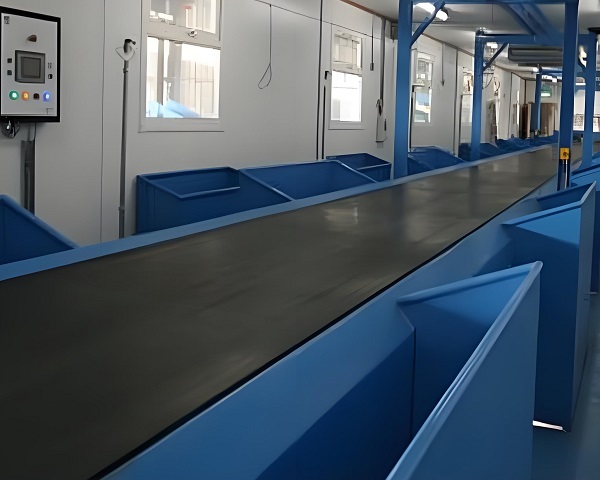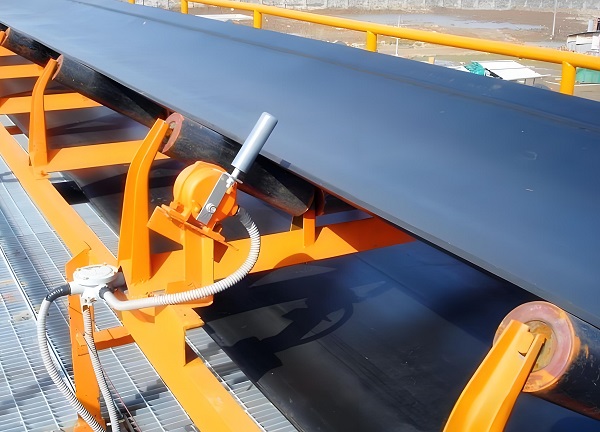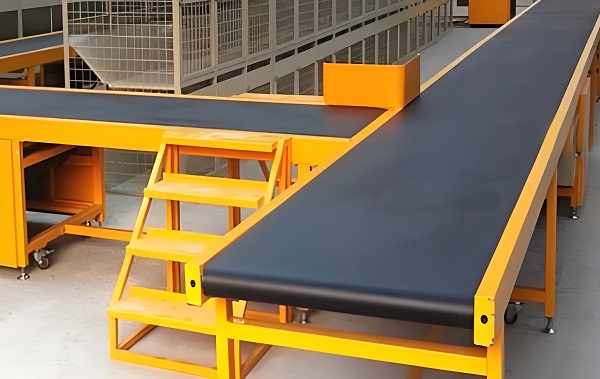In the critical chain of waste resource processing, the screening process is the core hub for achieving classified recycling and waste reduction. As the core vehicle for material flow, belt conveyors not only serve as the "link" connecting various screening equipment but also deeply participate in the screening process through their extended functionality. Faced with the challenges of complex waste composition and harsh processing environments, their adaptability and functionality directly impact system efficiency and sorting accuracy. This article focuses on the diverse roles of belt conveyors in waste sorting, analyzing them from basic transport to intelligent upgrades, highlighting their value as a "logistics hub."
In the waste resource processing system, the screening process is crucial for achieving classified recycling and waste reduction. As the core equipment for material transportation, belt conveyors not only perform the basic function of waste transfer but also, through coordinated operation with the screening equipment, directly impact screening efficiency, sorting accuracy, and system stability. From the entry of raw waste to the separation of final products, belt conveyors, with their flexible adaptability and multifunctional extensions, have become the irreplaceable "logistics hub" of the waste sorting system.
1.Basic Transportation: Building the "Material Artery" of the Screening Process

The core value of belt conveyors lies first in providing a continuous and stable material transport channel throughout the waste screening process, resolving the material connection challenges between different processing stages.
The first transportation scenario at a waste treatment plant is the initial transfer of raw waste upon arrival. After being weighed on a floor scale, the waste is dumped into a receiving pit by a loader. A heavy-duty apron feeder at the bottom of the pit evenly transports the material to a heavy-duty belt conveyor. This type of conveyor utilizes a high-strength polyester canvas belt core with a wear-resistant rubber cover, capable of withstanding impacts from metal, rocks, and other hard objects mixed in with the waste. With a conveying capacity of 100-500 tons/hour, it smoothly transports raw waste to the subsequent bag breaking and screening stages, preventing material accumulation and blockage.
In the multi-stage screening process, belt conveyors serve as a "relay transport" mechanism. For example, after the coarse material (larger than 80mm) is separated by a drum screen, it is transferred by a medium-sized belt conveyor to a crusher for crushing. The crushed material is then returned to the drum screen via another conveyor for re-screening. The medium material (30-80mm) that is screened is then directed by a dedicated conveyor to an air separation device to separate light combustibles from heavy inorganic materials. Different conveyor models, with precise height and angle design, ensure seamless material flow between screening equipment, ensuring a continuous and efficient screening process.
The sorting and transportation of end products relies even more on the precise distribution of belt conveyors. Recyclables such as plastics and paper are transported by light belt conveyors to their corresponding balers; food waste is transported by belt conveyors to anaerobic digesters; and the final inert soil is transported by wear-resistant belt conveyors to a landfill or brick-making plant. This sorting and transportation method avoids secondary mixing of different products, ensuring the purity of subsequent resource processing.
2. Auxiliary Screening: A "Functional Extension" to Improve Sorting Accuracy
In modern waste sorting systems, belt conveyors are no longer simply transport devices. By integrating specialized technologies, they have become a vital component of the screening process, significantly improving sorting accuracy.
Metal separation is most commonly achieved by combining them with magnetic separation technology. At the end of belt conveyors transporting raw waste or crushed materials, a permanent magnetic roller or electromagnetic iron remover is typically suspended. As the material reaches the end of the conveyor belt, ferromagnetic materials (such as nails, wire, and scrap steel) are attracted by the magnetic field, separated from the material flow, and dropped into a dedicated collection bin. Non-magnetic materials follow their normal trajectory and fall into subsequent equipment. This "conveying and sorting" model achieves metal recovery rates exceeding 95% without compromising conveying efficiency, making it widely used for extracting recyclable metals.
Combining this with air separation technology is particularly effective for separating lightweight materials such as plastics and paper. Directional air nozzles are installed above horizontal or slightly inclined belt conveyors. As the material is evenly spread across the conveyor belt, the airflow from the nozzles acts on the surface of the material, lifting lightweight plastic film and paper into a side collection hopper, while heavier materials like bricks and glass continue to move forward on the conveyor belt. Some advanced systems also incorporate suction devices beneath the conveyor belt, enhancing separation efficiency through negative pressure, raising the purity of lightweight materials to over 85%.
Vibrating belt conveyors solve the problem of sorting sticky materials. Raw waste, often composed primarily of food waste, tends to clump due to high humidity, making it difficult for conventional conveyors to achieve uniform distribution. Vibrating belt conveyors use high-frequency, low-amplitude vibrations during conveyance to loosen and separate stuck materials while evenly spreading them across the conveyor belt. This provides a uniform layer for subsequent optical or manual sorting, preventing missed materials due to material accumulation.
3. Adaptability: Meeting the Customized Needs of Waste Screening Scenarios

Waste materials are complex, corrosive, and contain a high concentration of debris. Belt conveyors require tailored structural designs and performance advantages to withstand these harsh screening environments.
Wear- and corrosion-resistant designs are key adaptability requirements. Food waste in garbage can produce acidic leachate, and the fumes from plastic incineration are corrosive. Therefore, conveyor belts must be made of acid- and alkali-resistant nitrile rubber or neoprene, while frames must be hot-dip galvanized or stainless steel to prevent rust damage. For applications involving large amounts of sharp, hard objects, such as construction waste, the conveyor belt surface is coated with a wear-resistant layer of ceramic particles or polyurethane, extending its service life by 3-5 times that of conventional conveyor belts.
Adjustable speed and variable frequency functions accommodate dynamic screening needs. Waste inflow fluctuates depending on time of day (for example, peak times are morning and evening). Belt conveyors utilize variable frequency motors to adjust conveying speeds (typically within a range of 0.5-2 m/s) based on the processing capacity of subsequent screening equipment. When the drum screen experiences minor blockage, the conveyor speed can be reduced to reduce the feed rate. When processing capacity is insufficient, the speed can be increased to increase system capacity and achieve a balance between supply and demand.
Flexible layout capabilities adapt to complex site conditions. Waste treatment plants are typically compact and require adaptation to varying renovation and upgrade schedules. Belt conveyors can be arranged in a variety of configurations, including horizontal, inclined, and curved. Curved belt conveyors, with their curved frame design, enable 90° or 180° material diversion, significantly saving site space. Retractable belt conveyors can adjust the conveying length based on the location of the material stack, flexibly adapting to varying unloading requirements. In addition, some conveyors are equipped with lifting devices that hydraulically adjust the conveying angle to accommodate equipment at varying heights.
4. System Value: The "Invisible Pillar" of Cost Reduction and Safety
The role of belt conveyors in waste screening systems lies in their comprehensive support for operating costs, production safety, and environmental protection requirements. Their system value far exceeds the purchase cost of the equipment itself.
In terms of cost control, the belt conveyor's efficient transmission characteristics significantly reduce energy consumption and labor costs. Compared to traditional bucket elevators or scraper conveyors, belt conveyors offer low operating resistance, consuming only 0.1-0.3 kWh/t of material per unit. They can also achieve continuous conveying over long distances (a single unit can reach over 100 meters), reducing equipment requirements and installation costs. Furthermore, the automated conveying mode eliminates the need for manual material handling, requiring only one or two inspectors per conveyor line, significantly reducing labor input and making them particularly suitable for large-scale waste treatment plants.
Another key benefit is production safety. The waste sorting process presents numerous safety hazards, such as material collapse and equipment jamming. Belt conveyors are equipped with multiple safety devices to effectively mitigate these risks: guardrails on both sides of the conveyor belt prevent falling material from injuring personnel; a deviation switch automatically shuts down the conveyor belt if it deviates from its track; a pull-cord switch allows the operator to disconnect the power supply at any time in an emergency; and a material blockage detector promptly detects material accumulation on the conveyor belt, preventing equipment overload and damage. These safety features have reduced the accident rate in the conveying process to below 0.1%. Environmental compliance support meets the stringent requirements of modern waste management. When conveying dust-prone materials (such as inert slag), belt conveyors can be equipped with enclosed protective covers or spray dust suppression devices to control dust concentrations below 10mg/m³, complying with the "Comprehensive Emission Standards for Air Pollutants." For materials prone to odor, such as kitchen waste, a gas collection hood can be installed above the conveyor belt to collect odorous gases for treatment in a deodorization system. Furthermore, the conveyor's low-noise design (operating noise level below 75 decibels) reduces noise pollution to the surrounding environment.
5. Technological Upgrades: The "Future Direction" of Intelligent Development

As waste sorting systems evolve towards intelligent and sophisticated features, belt conveyors are evolving towards integration and data-driven development, further expanding their role in the sorting process.
Intelligent monitoring systems enable real-time monitoring of equipment status. The new generation of belt conveyors is equipped with a variety of sensors, including temperature, vibration, and speed, which transmit operational data to the central control room via IoT technology. When the conveyor belt bearing temperature exceeds 80°C or the vibration amplitude is abnormal, the system automatically issues an alert. If the conveying volume fluctuates significantly, the feed rate can be adjusted via the front-end feeding equipment, achieving intelligent linkage within the "conveying-screening" system. Some equipment is also equipped with AI visual recognition technology, which uses cameras to identify large, unbreakable objects (such as concrete blocks and large furniture) on the conveyor belt and triggers a pneumatic actuator to remove them, preventing damage to subsequent equipment.
The integration of energy-saving and environmentally friendly technologies is another upgrade direction. Replacing traditional asynchronous motors with permanent magnet synchronous motors can reduce conveyor energy consumption by 15%-20%. Small solar-powered belt conveyors are suitable for small waste disposal stations in remote areas. Regarding environmental protection, breakthroughs have been made in the development of biodegradable conveyor belts, which decompose in the natural environment after disposal, reducing solid waste pollution. Furthermore, conveyor belt recycling technology, by renovating the cover layer, increases the utilization rate of old conveyor belts to over 70%, in line with the concept of a circular economy.
The modular design enhances the adaptability of the equipment. The new belt conveyor features a modular structure, allowing components such as the conveyor belt, frame, and drive unit to be quickly assembled and replaced based on actual needs. For example, if the screening process requires the addition of a magnetic separation step, the magnetic separation module can be directly installed on the existing conveyor. Changes in the type of material being processed require simply replacing the corresponding conveyor belt material (e.g., from wear-resistant to acid- and alkali-resistant), eliminating the need for a complete equipment replacement. This significantly reduces the cost and cycle time of system upgrades.
Belt conveyors offer both basic conveyance and extended functionality in waste sorting. They serve as the "material artery" connecting the entire process, enhancing precision through collaboration with technologies like magnetic separation and air separation, and offer customized designs to accommodate complex scenarios. Their systematic support for cost reduction, safety, and environmental protection, as well as their intelligent and modular upgrades, demonstrate their irreplaceable nature. From traditional conveyance to intelligent collaboration, belt conveyors have always been the core guarantee for the efficient operation of waste sorting systems, providing critical support for resource recovery.
Save Time! Get A Detailed Quotation Quickly.
